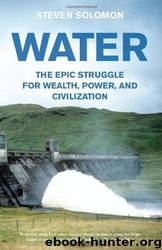Water: The Epic Struggle for Wealth, Power, and Civilization by Steven Solomon

Author:Steven Solomon
Language: eng
Format: mobi, epub
Tags: Technology & Engineering, Natural Resources, Environmental Science, Science, Nature, Water Supply, General, Environmental, Civilization, World, Water and civilization, History
ISBN: 9780060548315
Publisher: HarperCollins
Published: 2011-01-18T23:39:12+00:00
By every measure, the canal was a stupendous success. Within a decade, some 5,000 vessels were passing through it every year, as many as through Suez. By 1970, over 15,000 ships made the ten- to twelve-hour journey, paying annual tolls of over $100 million. Periodic enlargements and improvements permitted the passage of large warships and the growing fleet of oil supertankers and giant container ships that formed the backbone of the shipping revolution underpinning the rapid integration of the global economy in the late twentieth century. The canal represented the culmination of the historical transformation of the world’s oceans from restrictive boundaries into integrated superhighways that had begun with the European Voyages of Discovery four centuries earlier.
“The fifty miles between the oceans were among the hardest ever won by human effort and ingenuity, and no statistics on tonnage or tolls can begin to convey the grandeur of what was accomplished,” summed up David McCullough in his sweeping history of the canal. “Primarily the canal is an expression of that old and noble desire to bridge the divide, to bring people together. It is a work of civilization.”
For America, the Panama Canal stood as a beacon of the nation’s arrival as a star among world civilizations. It was a national historic turning point when many of the society’s dynamic forces coalesced to open a new era. At last, America was in a position to fulfill its continental promise of marrying the maritime resources of its two ocean frontiers. U.S. exports and investment abroad soared after the canal’s opening. Overseas markets and raw materials were immediately drawn into the productive circuit of America’s prolific industrial economy. By 1929 the United States was producing nearly half the world’s total industrial output.
Likewise, the Panama Canal marked the transition between the first and second of American naval history’s three eras. It ended the long period when America’s navy was focused chiefly on defending the young country’s borders and waterways, protecting free trade and market access for its seafaring merchants while opportunistically promoting continental expansion. After Panama, naval orientation projected American power outward to arbitrate affairs within Europe and Asia, while expanding American commercial and military access throughout the world. The United States entered World War I to make the world safe for democracy, as President Woodrow Wilson explained, when German submarines began sinking U.S. and other formally neutral merchant and passenger ships in its effort to break Britain’s control of the seas and blockade of its ports. Throughout the third era dating from World War II, the mighty U.S. Navy patrolled the globe’s oceans and strategic passages, peerless and rarely challenged, to uphold the international free world order of which America itself was the undisputed leader. American aircraft carriers were the state-of-the-art naval weapon of World War II. Most famously, aircraft carriers played the decisive role in the pivotal Battle of Midway (June 1942) that determined control of the Pacific Ocean. The Japanese navy that had inflicted such a terrible, surprise first strike on the
Download
Water: The Epic Struggle for Wealth, Power, and Civilization by Steven Solomon.epub
This site does not store any files on its server. We only index and link to content provided by other sites. Please contact the content providers to delete copyright contents if any and email us, we'll remove relevant links or contents immediately.
| Acoustics | Bridges |
| Earthwork Design | Environmental |
| Fire Science | Highway & Traffic |
| Hydrology | Remote Sensing |
| Seismic Design | Structural |
| Structural Dynamics | Surveying & Photogrammetry |
| Transportation |
Whiskies Galore by Ian Buxton(41874)
Introduction to Aircraft Design (Cambridge Aerospace Series) by John P. Fielding(33064)
Small Unmanned Fixed-wing Aircraft Design by Andrew J. Keane Andras Sobester James P. Scanlan & András Sóbester & James P. Scanlan(32743)
Craft Beer for the Homebrewer by Michael Agnew(18140)
Turbulence by E. J. Noyes(7935)
The Complete Stick Figure Physics Tutorials by Allen Sarah(7307)
Kaplan MCAT General Chemistry Review by Kaplan(6866)
The Thirst by Nesbo Jo(6826)
Bad Blood by John Carreyrou(6546)
Modelling of Convective Heat and Mass Transfer in Rotating Flows by Igor V. Shevchuk(6391)
Learning SQL by Alan Beaulieu(6209)
Weapons of Math Destruction by Cathy O'Neil(6142)
Man-made Catastrophes and Risk Information Concealment by Dmitry Chernov & Didier Sornette(5921)
Digital Minimalism by Cal Newport;(5662)
Life 3.0: Being Human in the Age of Artificial Intelligence by Tegmark Max(5474)
iGen by Jean M. Twenge(5366)
Secrets of Antigravity Propulsion: Tesla, UFOs, and Classified Aerospace Technology by Ph.D. Paul A. Laviolette(5309)
Design of Trajectory Optimization Approach for Space Maneuver Vehicle Skip Entry Problems by Runqi Chai & Al Savvaris & Antonios Tsourdos & Senchun Chai(5011)
Pale Blue Dot by Carl Sagan(4909)
